This week I got the chance to interview a representative of the International League of Conservation Photographers (iLCP). They’re a great conservation organisation that are using the camera lens to make a positive change in our world. Take ten minutes out of your day to find out more about them.
I’m sure there are going to be a lot of people who have never heard of the International League of Conservation Photography (iLCP). In your own words, can you tell me a bit about the aims and objectives of the organization?
The iLCP was established in 2005 with the goal of enlisting the skills and expertise of some of the best photographers in the world to advance conservation efforts around the globe. We are a project-driven organization that partners with leading scientists, policy makers, government leaders and conservation groups to produce the highest-quality documentary images of both the beauty and wonder of the natural world and the challenges facing it.
Our mission is to further environmental and cultural conservation through ethical photography. We believe that awe-inspiring photography is a powerful force for the environment, especially when paired with the collaboration of committed scientists, politicians, religious leaders and policy makers. We aim to replace environmental indifference with a new culture of stewardship and passion for our beautiful planet.
You can see all of our objectives here: http://www.ilcp.com/about/mission-objectives
Basically, to put it all in simpler words, our mission is to provide the visual assets necessary to help conservationists worldwide push forward environmental issues. One way we do this is by pairing our Fellow Photographers with conservation groups who have need of impactful imagery to help them communicate the threats and opportunities of the conservation efforts they are working on. We conduct conservation photography expeditions to get these images. These groups become our conservation partners and together, we use the great power of photography to help bring about change that will make this planet a better world for all.
Another key iLCP activity is promoting the individual projects being carried out by all of our individual Fellow Photographers worldwide (now counting 117). The organization serves as a sort of channel for all our Fellows to increase their reach to new audiences with the aim of sensitizing them about a wide variety of conservation causes and inciting them to action. We have Fellows working on every continent, and together we want to show what is happening to the world.
Finally we are also very committed to expanding the reach of conservation photography to new communities. Through our Speaker’s Bureau, our Fellow photographers can be engaged to come speak about many different conservation topics. Our Image Licensing services offer our images to both for profit and non-profit conservation minded organizations that want to make sure they are using only ethically sources photographs of the very highest quality on their websites or publications. These two programs help to bring powerful conservation imagery, and ultimately conservation messaging, to a broader public.
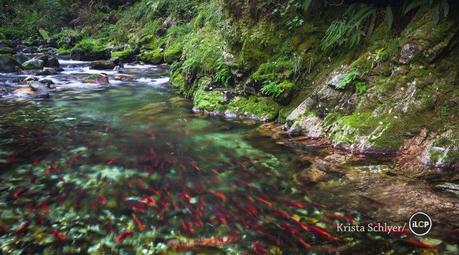
Kokanee salmon spawning. The Clearwater Expedition looked into land and forest use in the Clearwater Basin of Idaho, one of the largest expanses of wild forests in the lower 48 states.
Every year iLCP runs a number field expeditions that focus on a conservation issue to different regions of the world. Can you explain to me how these conservation issues are chosen?
It depends. Since a large part of iLCP’s mission is to partner up with scientists and conservation organizations, the ideas for expeditions mostly come from our partners. It’s important for us to rely on these partners, since we don’t want to get involved in just a field trip, but rather in a whole campaign. As we say very often, iLCP is not about taking pretty pictures, it’s about communicating a strong conservation message.
For example, in 2013, an organization called “Project Seahorse” came to us with an idea for an expedition to raise awareness on coral reef conservation in the Philippines, and from there, we launched the Danajon Bank Expedition. They came to us not just with the idea of a trip to the Philippines, but with a wider strategy on how they can work with iLCP and use our photos to communicate their message, reach new and larger audiences, and achieve concrete goals for the protection of the area. They also brought a number of other partner organizations on board. Their plans included publications, exhibits around the globe, education campaigns, and plans to present the expedition work to national and international bodies to seek protection. The same applies to all of the expeditions we launched in 2013, but on various scales – some have a more local focus, some more international.
In the past, there have also been situations where iLCP is the one that decided on the destination and the campaign. At the root of all of this is funding and the interest of our Fellows. Expeditions, of course, can cost a lot of money. Just think of the cost of transportation, accommodations, food, as well as a small compensation for our photographers. If iLCP holds the discretionary funds to launch our own expeditions and campaigns, then we can get our Fellowship together, decide on a priority destination or issue, and launch an expedition. This has happened several times in the past. But lately, we have found it more effective to partner up with conservation organizations as explained above.
Pearl farm divers retrieving oyster nets in open ocean. This expedition looked into the health of the coral reef around the Gambier Islands in French Polynesia.
There were five field expeditions in 2013. Obviously one part of the job of iLCP photographers is to go out into the field and take photos that best highlight a conservation issue. How does iLCP follow up on these expeditions and what kind of approach to advocacy does iLCP take?
There were actually 6 expeditions, one of them is not on our website since the photos resulting from it were only meant to be used internally by our partner organization.
The work we do on expeditions can go on for years after the photos were actually shot, and our advocacy can take many different shapes. Immediately, as the expedition is going on or right after it is over, we use the media to bring attention to the cause. We have partners in many major media outlets, through which we spread the news about our expedition, and also the issues our partners are working on.
Afterwards, a lot depends on what our partner wishes to achieve. Some campaigns are very local in nature, some are global. So this would determine if, let’s say, iLCP works with the photographers and the partners to hold a lecture in a local school, or an exhibit that goes on a global trajectory. Or, if we launch a poster campaign through a small regional NGO, or work to get an article about the expedition in a major international publication. It all depends greatly on the nature of the expedition and the communication strategy and scope devised by iLCP and the partner.
But one way or the other, one thing iLCP helps to do is bring more attention to the conservation campaigns we join, and provide our partner the best possible images to illustrate their work.
An additional factor here is not just iLCP’s advocacy as an organization, but also the involvement of the individual photographers involvement. iLCP’s Fellows are very carefully chosen, and along with having world-class talent, we also want them to show commitment to conservation causes. So while iLCP will do a lot for advocating a cause, the individual photographers will sometimes do even more. It’s all part of the package that partnership with iLCP can offer. Our photographers in the past have embarked on lecture tours, held exhibits, and engineered thousands of articles in the world’s top publications, just to give a few examples, all in support of iLCP expeditions.
Are there certain issues that iLCP has worked on that have really resonated with the public?
That is a difficult question. All of our expeditions have resonated with the public, just not always the same people, in the same location and in the same way. As I explained earlier, some of our expeditions are more local in scope, some more international, and the outreach to the public is tailored accordingly.
One thing that really attracted the public’s attention there was our documentation of the “spirit bear,”
But, if I had to pick just one, I would say that our Great Bear Rainforest expedition in Canada’s British Columbia had probably resonated the most with the general public. This expedition documented the people and the area which would be affected by the planned construction of an oil pipeline and seaport on Canada’s west coast. It became a cover article in National Geographic magazine, and the film that came out of it, “Spoil,” has been viewed around the globe, winning multiple awards on the way. This global exposure contributed to make this probably our most popular expedition yet.
One thing that really attracted the public’s attention there was our documentation of the “spirit bear,” which is the white variety of the black bear. These are not albino bears, but rather, a genetic mutation turns these bears’ coat white. The Great Bear Rainforest is the only place in the world where these bears are found, and there are only about 400 in existence. Except for locals, almost nobody had ever heard of these bears, and the photos were a surprise to most. Right away, the spirit bear became a icon of the region’s environmental struggle, and garnered attention worldwide.
Our partners in British Columbia have been very adept at using iLCP’s images effectively to attract the public’s attention towards the environmental debate surrounding the pipeline. Our images of the area’s animals, vegetation, and people, helped to clearly illustrate what is at stake, and they continue to do so, since the pipeline construction debate is not over. So while all our expeditions find an audience, our Great Bear Rainforest expedition has probably resonated the most with the public.
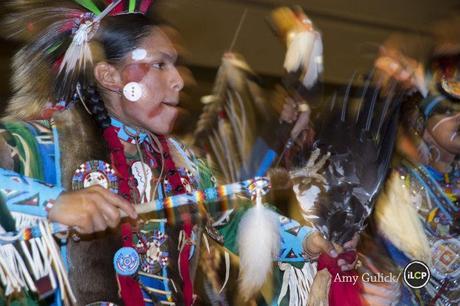
Young man dancing at a pow wow, Lewiston, Idaho, U.S.A taken during the Clearwater Basin Expedition. In its expeditions, iLCP has worked repeatedly with indigenous groups from all parts of the globe.
In your mind, which of the numerous field expeditions that iLCP has run has been the most successful?
That is another difficult question, because success is measured differently in every expedition. Some expeditions might have results that are less flashy and less well-known, but end up just as effective as the larger, more visible ones.
Our success as well is only possible through the tireless work of our partners. We can never take the credit alone for the victories that can derive from our expeditions.
In terms of measurable, concrete successes, we can mention for example, that from our multiple expeditions to Mexico, two new National Parks were created there. Also, in Canada’s British Columbia, our efforts have helped to convince the government to declare two areas off-limits to oil and mineral exploitation.
Some of these successes also only come many years after our expeditions to a certain area. So, as iLCP is still a relatively young organization, there are still many victories to come.
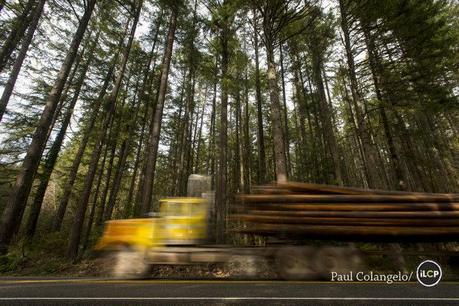
Logging interests and organizations working for the protection of the forest have divided opinions on the future of Southwest Oregon’s forests.
What projects/ issues will iLCP be working on in 2014?
2014 will probably be our busiest yet. We have a large number of new and current partners knocking at our door with expedition proposals, and we also have a few expedition ideas we are working on ourselves. At the moment, there are three expeditions confirmed, and up to seven in the works. The three that are confirmed are, 1) a continuation of our 2013 expedition to the Island of Chiloé in Chile, 2) a return expedition to the Meso-American reef in Honduras, and 3) the Peel River watershed in Canada’s Yukon. The other possible expeditions are in South America, Asia and North America, but we cannot confirm them just yet.
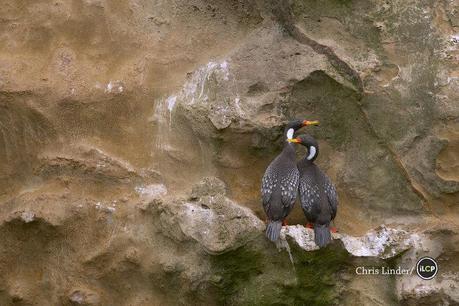
Pair of Red-Legged Cormorants (Phalacrocorax gaimardi) taken during the Chiloé Island Expedition. It is considered near threatened under the IUCN Red List of Threatened Species.
Is it possible for amateur/ semi-professional photographers to support the work of iLCP?
The iLCP fellowship is composed of 117 of the world’s top professional wildlife, nature and culture photographers, and we only work with these photographers. This is very important for us, and that is part of the product that iLCP offers. Our Fellows are very carefully selected for their talent, dedication and professionalism. When we partner up with an organization, we promise them the best possible photography, the highest skill level, and a strong international reputation to follow. That is also why these organizations come to us.
We are currently looking into a model that would permit amateur and semi-professional photographers to take a more active role
That said, in the past, we have had a few “guest photographers” on some expeditions. That is exceedingly rare, and usually in cases where the partner organization was already working with a photographer.
That also said, we are currently looking into a model that would permit amateur and semi-professional photographers to take a more active role in conservation issues. We are not ready yet to announce this initiative, but we are working on it. We are fully aware that there is a ton of talent out there outside of our Fellowship, and that there are millions of conservation issues that need coverage and exposure – more than we could ever realistically work with. So, we are looking into it, and hope to announce a new initiative or partnership soon.
But there are always ways to support us. Follow us on Facebook and Twitter (@iLCP), and share our stories. If you know of conservation organizations that would benefit from partnering with us, please let them know about iLCP. In fact, one of our 2013 expeditions happened exactly in that way – a photographer who wanted to help a conservation organization recognized that they would benefit from the incredible imagery and international exposure provided by iLCP. He put us in touch, and we are now working together.
Additionally, one very effective way to support us is to donate to our activities. Expeditions can only happen when we can afford them, and without the support of our many donors, none of our efforts would be possible.
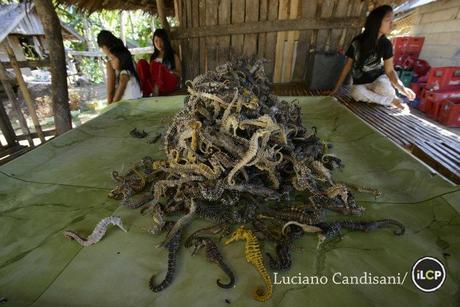
Though seahorse fishing is illegal in the Philippines, small-scale fishers here and in other developing countries contribute to the global wild seahorse trade, which exceeds over 15 million animals per year, putting great pressures on the species. The seahorses are dried and used in Chinese traditional medicine.
Is there a process for local organizations working on conservation issues to get in touch with iLCP about working together?
The best thing to do is to send us an e-mail at [email protected], explain your cause, your goal, your funding situation, and we will get back to you. Before we decide to undertake an expedition, we discuss many topics with the potential partner, from advocacy goals, to transportation logistics, to weather, to the photographers’ expertise – you name it! Another important issue, of course, is funding. We will need to discuss how this expedition will be funded, and by whom. But the first step is the easiest, just send us an e-mail.Any final remarks you’d like to make about the work of iLCP or issues you’d like to highlight?
What drives all of our iLCP photographers, staff and partners, is a great passion for our planet and all of the beings upon it. We want to find sustainable solutions to the environmental challenges faces us, and we do this by providing you the necessary visual references to influence your choices and decisions. Images have the power to attract attention rapidly and communicate a message much more rapidly than the written word, and we are using this power for positive environmental change.
Please follow iLCP on Facebook and Twitter for the latest news on the conservation work being done by our photographers and the organization. Also, join our mailing list for the latest news:
http://www.ilcp.com/about/contact
Our work can only happen through the generosity of our supporters. iLCP is a non-profit, non-governmental organization and gets all of its funding through donations. If you would like to help, click below:
https://ilcp.wufoo.com/forms/thank-you-for-your-support
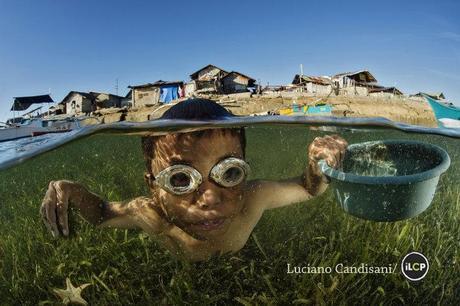
Marven Jay collects nudibranch eggs for dinner during the low tide. The Danajon Bank Expedition, iLCP’s largest in 2013, looked into the health of the Danajon Bank coral reef and into sustainable solutions to human use of that area of the Philippines.
